A robust and highly sensitive direct inject microflow LC-MS/MS method for antisense oligonucleotide quantification in plasma
Increasing sensitivity for oligonucleotide quantification using the SCIEX 7500 system, powered by SCIEX OS software
Remco van Soest and Eshani Nandita
Biopharma
SCIEX, USA
Abstract
This technical note describes how low limits of quantification (LLOQs) for antisense oligonucleotides (ASOs) in rat plasma are achieved by using a direct inject microflow method. Sensitivity and quantitative performance are comparable to previously published data acquired using a trap-and-elute microflow LC method on a SCIEX 7500 system.
Introduction
A simple and easy to operate direct inject workflow was developed for sensitive analysis of oligonucleotides with excellent quantitative performance and low carryover.
Oligonucleotide therapeutics and gene therapies are rapidly gaining attention as their potency improves and delivery challenges are addressed. Modalities such as ASOs are becoming more important due to their high specificity and ability to reach formerly undruggable targets. Sensitive and robust methods for quantitative analysis of oligonucleotides are needed to support the development of ASO therapeutics. LC-MS/MS can provide excellent selectivity, good sensitivity and the ability to analyze multiple oligonucleotides in a single assay. However, for studies where sample is limited, such as preclinical pharmacodynamic studies in rats or mice, sensitivity can still be insufficient. Additionally, bioanalysis workflows for oligonucleotides that feature a simple method setup while maintaining the desired sensitivity and low carryover still remain challenging to achieve.
Table 1. LLOQs achieved for different ASOs in rat plasma using a direct inject microflow LC method and the SCIEX 7500 system.
Herein, a direct inject microflow LC was paired with the SCIEX 7500 system to quantify several ASOs in rat plasma. Impressively low LLOQ levels, wide LDR and low carryover for ASO quantification were achieved with excellent quantitative performance.
Key features
Key features of the microflow workflow using the SCIEX 7500 system for oligonucleotide quantification
- Achieve low-pg/mL LLOQs for ASOs in rat plasma for pharmacokinetic studies faced with sample limitations
- Perform sensitive quantitative analysis of oligonucleotides with a simple and easy to operate direct inject microflow LC platform featuring low carryover
- Save time by easily switching between analytical and microflow setup with no need for electrode position optimization, using the OptiFlow Pro ion source with E Lens probe
- Reduced consumption of LC-MS grade ion-pairing reagents provides significant savings and increases robustness
- Greater ion generation and ion transmission on the SCIEX 7500 system enables significant gains in sensitivity compared to the previous generation instruments
- SCIEX OS software increases productivity by providing a user-friendly interface and compliance-ready platform for data acquisition, processing and management
Methods
Samples and reagents: Fomivirsen, nusinersen, eluforsen, a model fully phosphorothioated 2’O-methylated oligonucleotide with the sequence mU*mA*mU*mC*mC*mG*mC*mC*mU*mC*mG*mU*mG*mA*mG*mA*mA*mG*mA*mU and an internal standard with the sequence CATGGTCCTGCTGGAAGTTCGTG were all purchased from IDT. The ion-pairing reagents 1,1,3,3,3-hexafluoroisopropanol (HFIP, ≥ 99.8%) and diisopropylethylamine (DIEA, ≥ 99.5%) were purchased from Sigma Aldrich. Ethylenediaminetetraacetic acid (EDTA) was also purchased from Sigma Aldrich.
Sample preparation: Calibration curves were prepared by spiking analytes and internal standard (500 ng/mL) in extracted rat plasma (Sprague Dawley, K2 EDTA, BioIVT). 1 mL plasma samples were extracted using Clarity OTX solid phase extraction (SPE) cartridges (Phenomenex) following the manufacturer’s protocol for extracting oligo therapeutics from biological samples. After drying with nitrogen gas at 40°C, the plasma extract was reconstituted in 1 mL mobile phase A containing 100 μM EDTA.
Chromatography: A SCIEX M5 MicroLC system was used in direct inject mode with a flow rate of 10 μL/min. Gradient and other chromatographic conditions and column are summarized in Tables 2 and 3. A volume of 10 μL of reconstituted sample was loaded directly onto the microLC column.
Table 2. LC Method.
Table 3. Chromatographic conditions.
Mass spectrometry: A SCIEX 7500 system with an OptiFlow Pro ion source with E Lens probe and a micro (low) electrode was used in MRM mode. All source and MS parameters were optimized (Tables 4 and 5). The MS method included two MRM transitions for each analyte and 1 MRM transition for the internal standard (IS).
Table 4. Source conditions.
Data processing: MRM data were processed with SCIEX OS software 2.2 using the MQ4 integration algorithm. A 1/x2 weighting was used for quantification.
Table 5. MRM transitions and MS parameters.
Results and discussion
Figure 1 shows baseline separation achieved for the 4 oligonucleotides and the internal standard. MRM transitions used for the quantification of oligonucleotides and their metabolites or impurities often share the same fragment and there is possible overlap among the precursors because of the large number of charge states with similar intensities. Therefore, it is important to have good chromatographic separation of all analytes and the internal standard.
Calibration curves were measured in triplicate for all the analytes by spiking the analytes into plasma extract in the concentration range between 0.01 and 300 ng/mL. Good accuracy and precision were achieved for all analytes (Table 6). LLOQs and linear calibration curve ranges were determined based on the requirements that the %CV of the calculated mean of the concentration is below 20% at the LLOQ and below 15% for all higher concentrations, while the accuracy of the calculated mean is between 80% and 120% at the LLOQ and between 85% and 115% for higher concentrations.
The LLOQs for fomivirsen and nusinersen were found to be 0.01 ng/mL. This was the same as for the trap-and-elute method described in our previous technical note where we analyzed 30 μL of sample.1 However, the S/N ratio was 3–4x lower for the 10 μL direct injection method. As a result, the LLOQs for the measured oligonucleotides using the trap-and-elute method are theoretically lower than what was measured for the trap-and-elute technical note.1 Nevertheless, the direct inject workflow presents an excellent quantitatively sensitive method for ASO analysis. For methyl-oligo and eluforsen the LLOQs and S/N ratios were 3x lower, which corresponds with the 3x less amount of sample injected. ULOQs were higher by a factor of 3x as well with the LDR between 3.5 and 4.5 orders of magnitude.
Figure 1. XICs for the MRMs of 4 ASOs and the IS. 2 MRM transitions were used for each analyte and 1 for IS. Baseline separation was achieved using a 3 min gradient.
Table 6. Calculated concentration, precision and accuracy for each oligonucleotide at each concentration.
Figure 2. Calibration curves based on IS-adjusted XIC areas for each of the oligonucleotides. Linear dynamic ranges were between 3.5 to 4.5 orders of magnitude.
Figure 3. XICs for the MRM transitions of each analyte. Blanks from extracted plasma (left) and ASOs at their LLOQs (right). No noticeable interference was observed in the matrix blank.
Figure 3 shows the XICs of all analytes for a blank extracted plasma injection (left) and at their LLOQ levels (right). No significant interferences were observed, illustrating efficient clean-up of the plasma matrix using the Clarity OTX SPE cartridges.
Carryover was determined to be around 0.3% in the first blank after injecting the ULOQ. While still high, it was lower carryover compared to the 0.5% that was found with the trap-and-elute method. As the carryover was determined to come almost exclusively from the column and/or tubing and not from the autosampler, the observed lower carryover compared to the trap-and-elute method may be because in the trap-and-elute method the trap column adds to the carryover. The carryover could be further reduced by adding additional wash steps in the gradient method if the full linear range is required or alternatively the ULOQ could be lowered.
Robustness
To evaluate the robustness of the inject method, 100 consecutive injections of the rat plasma spiked at the 10 ng/mL level were made. Figure 4 illustrates the excellent retention time stability, < 0.3% RSD, that was achieved for all 4 analytes. Figure 5 shows the column pressure traces of the first, 50th and 100st injection. The backpressure did only change by a small amount over these 100 runs, for example, clogging the microflow LC column with the (for microflow LC) relatively large injection volume of 10 μL did not appear the be a problem with the Phenomenex OTX prepared plasma samples.
Figure 4. Retention time plotted versus 100 consecutive injections. RSD was < 0.3% for each of the oligonucleotides.
Figure 5. LC column pressure for the 1st, 50th and 100th injection. Pressure varied minimally over the course of 100 consecutive plasma extract injections.
Conclusion
- Ultra-low LLOQs (10–100 pg/mL) for ASOs in rat plasma were achieved using a direct inject microflow LC method coupled to the SCIEX 7500 system
- A simple direct inject microflow LC method was developed with low carryover for the quantification of ASOs in rat plasma
- Up to 25–50x lower solvent consumption compared to an analytical flow method resulting in significant savings in expensive, high-purity modifiers such as hexafluoroisopropanol
- Lower solvent consumption also promotes robustness by reducing the level of ion-pairing reagents introduced into the mass spectrometer
References
- Achieving best in class sensitivity for antisense oligonucleotides in plasma using trap-and-elute microflow LC. SCIEX technical note, RUO-MKT-02-13206-A.
 Click to enlarge
Click to enlarge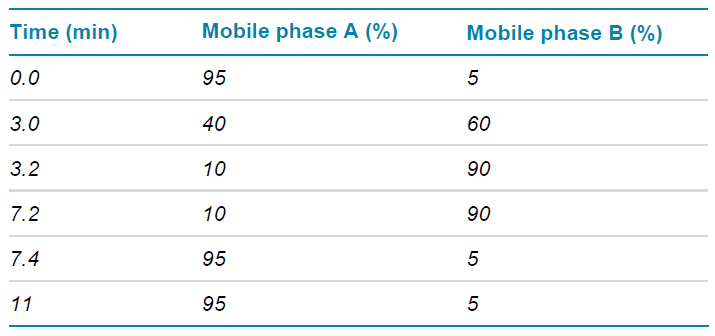 Click to enlarge
Click to enlarge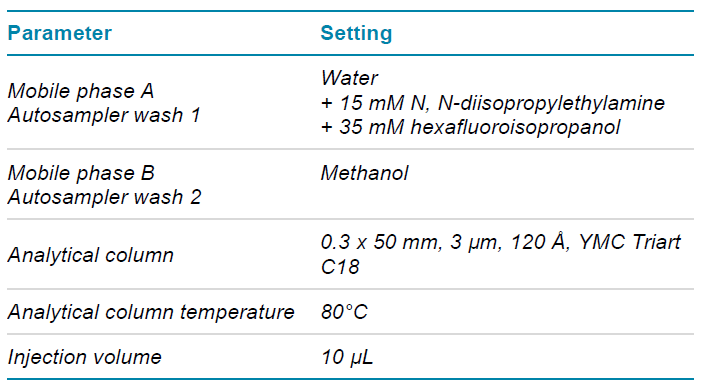 Click to enlarge
Click to enlarge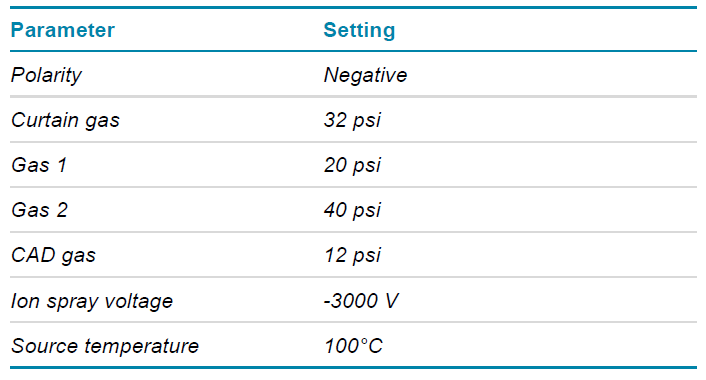 Click to enlarge
Click to enlarge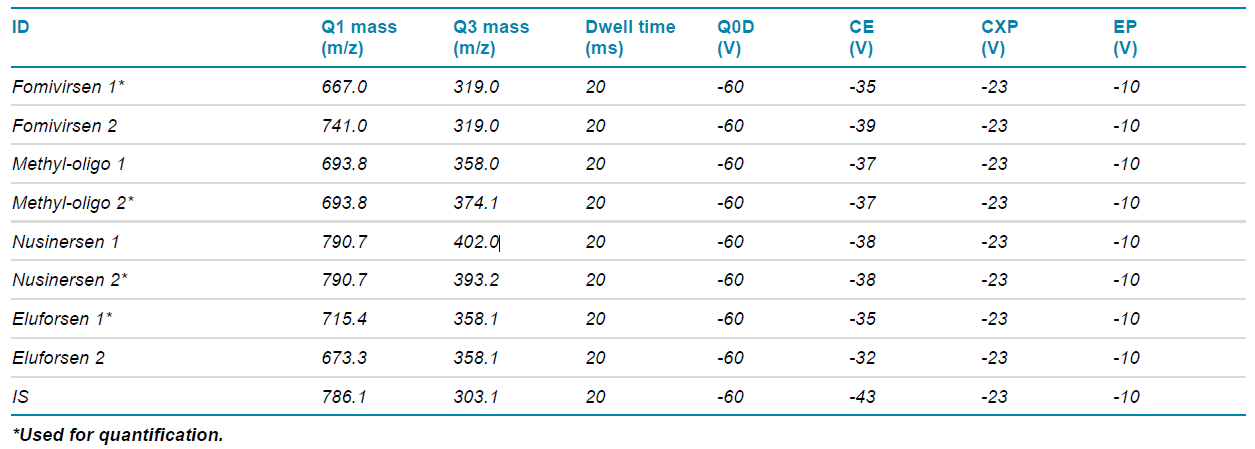 Click to enlarge
Click to enlarge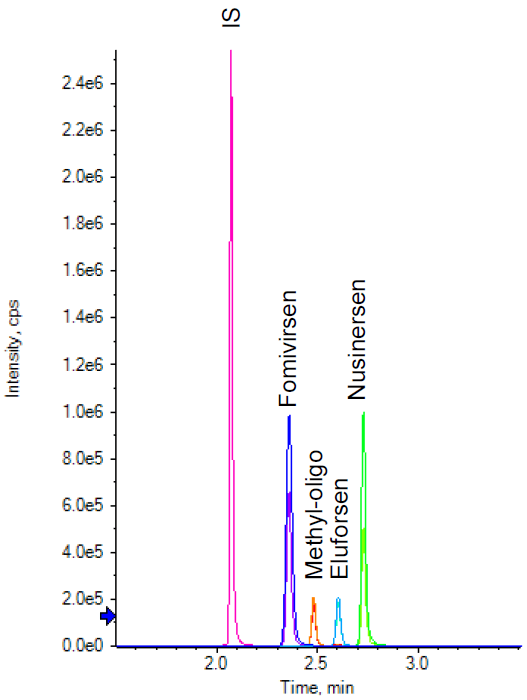 Click to enlarge
Click to enlarge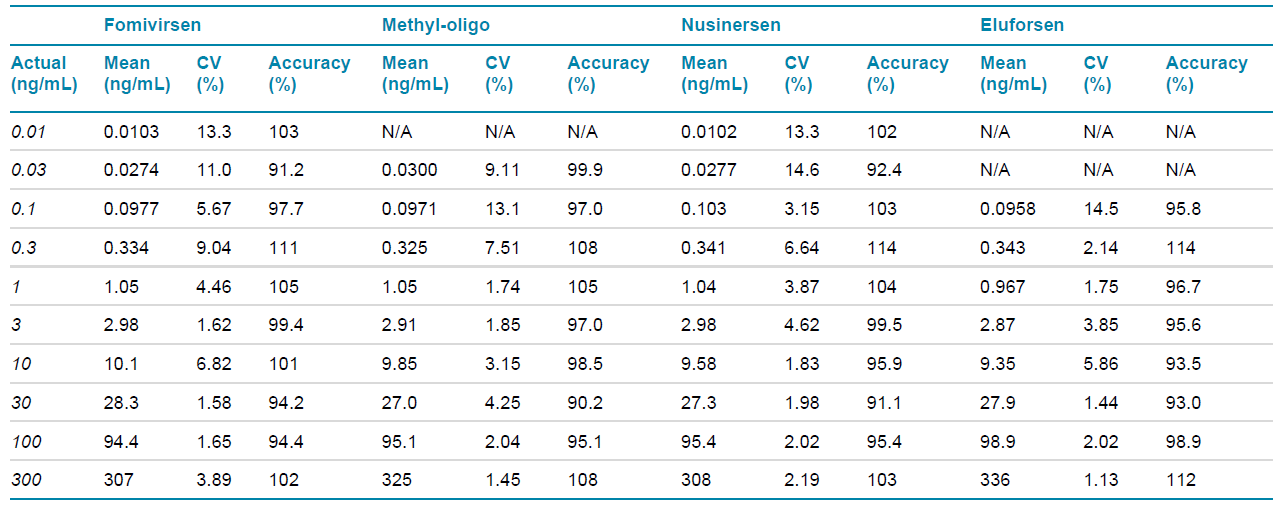 Click to enlarge
Click to enlarge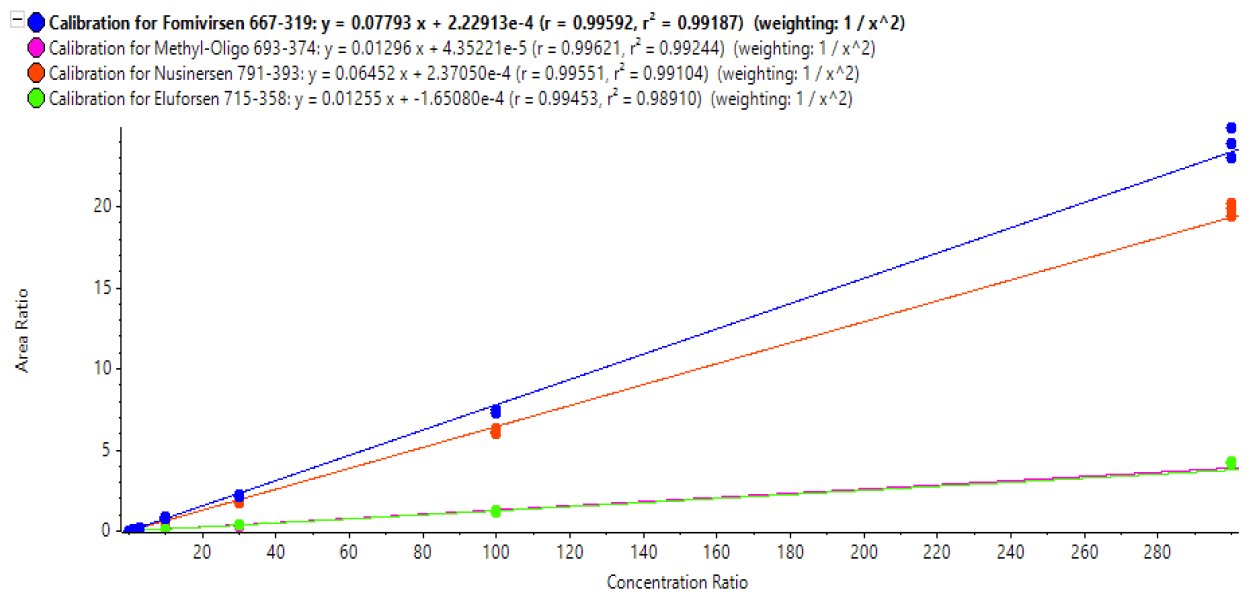 Click to enlarge
Click to enlarge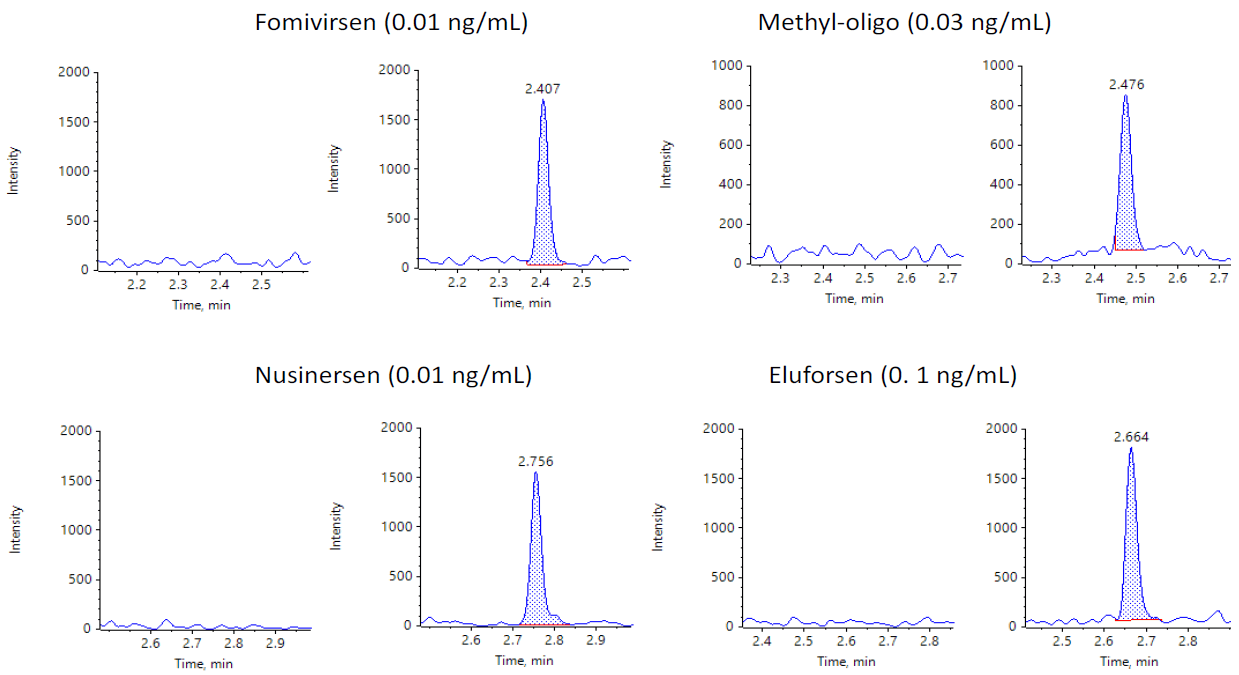 Click to enlarge
Click to enlarge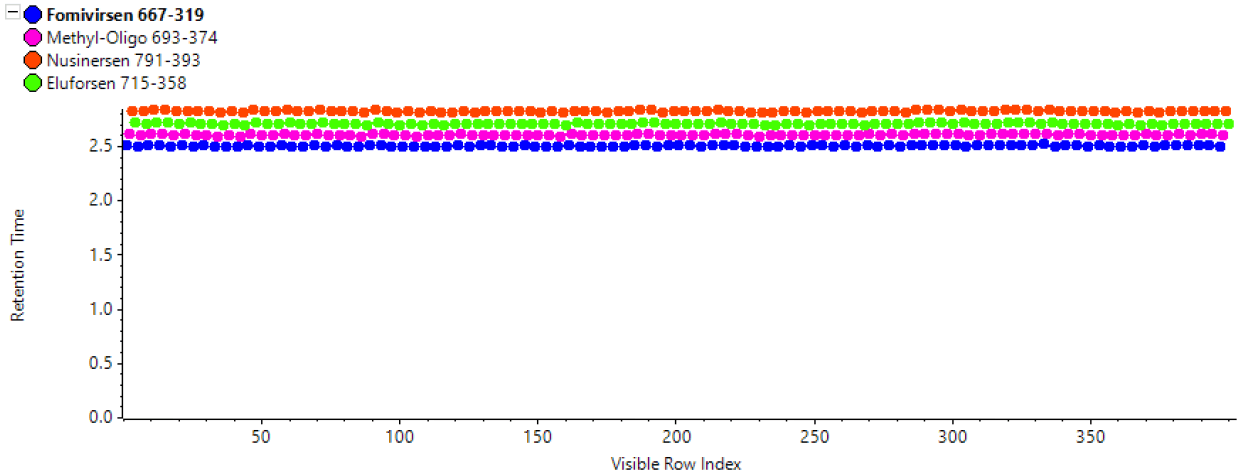 Click to enlarge
Click to enlarge Click to enlarge
Click to enlarge